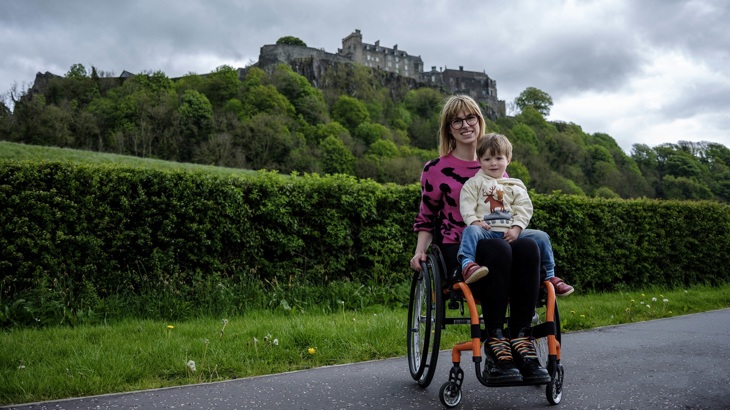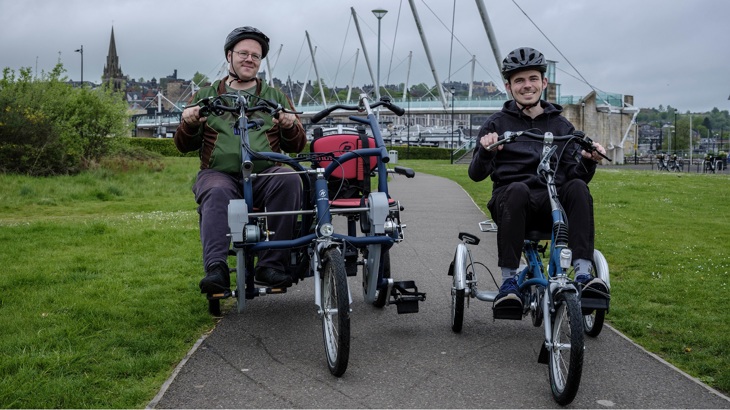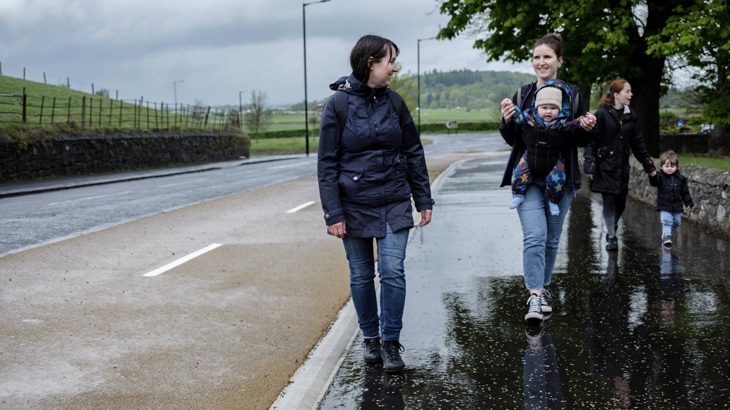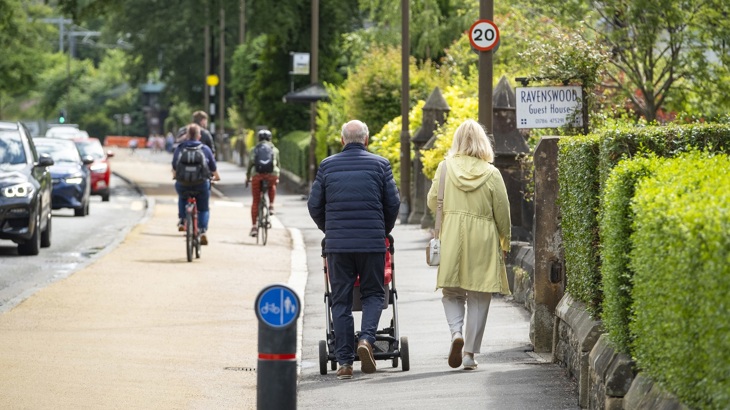In the latest Walking and Cycling Index, 25% of respondents in Stirling said they don’t currently cycle but would like to. To find out more, we met the people behind a programme helping people cycle in the city and who are working with Sustrans and the city council to revolutionise infrastructure for people walking, wheeling and cycling.
What is the Walking and Cycling Index?
The Walking and Cycling Index is the biggest assessment of walking, wheeling and cycling in urban areas in the UK and Ireland. In Scotland, the Index is delivered by Sustrans in collaboration with eight cities, and funded by Transport Scotland. Each city reports on the progress made towards making walking, wheeling and cycling more attractive, everyday ways to travel.

This is the third time we've collaborated with Stirling City Council to survey active travel in the city. Credit: Brian Sweeney/Sustrans
The Index reports every two years. This is the third report from Stirling produced in partnership with Stirling Council. The data in this report comes from 2023 and includes local walking, wheeling and cycling data, modelling and an independent survey of 1,174 residents aged 16 or above in the city.
Breaking down barriers
Bikes Without Barriers is Active Stirling’s adapted cycling programme. The programme supports people who live with a disability or who face barriers to participating in cycling, giving them an opportunity to cycle in the city and use different bikes that suit their needs.
Vikki leads the programme and said: “Some of the barriers that people who attend Bikes Without Barriers face could be that they’re wheelchair users so they’re not ambulant, so we can use a wheelchair loader bike, where they have someone cycling it for them. It could be that they need to have three wheels instead of two, just to give them a bit more balance. We also have side-by-side bikes, where they can have someone cycling and they can be sat beside them. And it just gives them a real sense of freedom, independence and exhilaration.

Bikes Without Barriers is Active Stirling’s adapted cycling programme. Credit: Brian Sweeney/Sustrans
“We have weekly cycle sessions, and we probably have on average about 45 distinct participants every week. We have some young children from primary school who we try and introduce to the bikes quite early, so they can also join in the Bikeability sessions that run within the schools. Then we have some children who are high school age. And then we move onto adults as well, from the community or from day centres. The needs are all very varied and wide, but everybody mixes in and just gets on with it, which is what makes the programme special.”
Impact of the work
Katie has been coming to Bikes Without Barriers for two years and said: “What I enjoy about Bikes Without Barriers is meeting new friends, volunteers and enjoying the freedom! And learning to use the side-by-side bike which I absolutely love. I feel more secure and safe, knowing there's somebody else in control of the bike. I've been doing it for two years and it's the best thing I’ve ever done!
“ I just want everybody who is visually impaired or got other disabilities to come and join in because it's fantastic and they'll get the use out of it!
“All the cycling team have been so good, scribing the route and things like that. It has built my confidence, and I hope to do it more and more. I just don't know where I would be without the guys of Bikes Without Barriers.”
Vikki discussed the impact of the programme: “We’ve got people who physically are feeling better. We’ve had people who’ve lost lots of weight and reversed their diabetes, so they’re a lot healthier. We have a lot of people who can’t even move one side of their body, and now are starting to move and use certain parts of their body. It’s slow, but they’re progressing, so that’s a massive impact for us and for our programme that keeps us going.
There’s a social aspect, too. We’re a community. We have people who sometimes don’t speak to anybody for days, but come along, and they’re there and they’re having a chat and getting to meet everybody and enjoy the social benefits of being in a community. It is really about building a nice safe environment for everybody to feel that they can be themselves and have a bit of fun."
Walk, Cycle, Live Stirling
Breaking down barriers to cycling participation is hugely important. But what about making changes to the roads and paths on which we cycle? Due to be completed in 2024, the Walk Cycle Live Stirling project aims to deliver a total of 6.5km of segregated paths across two routes, connecting communities in the city and surrounding areas through active travel in a major way. It also aims to increase economic activity and footfall for local businesses.

People walking and cycling on part of the Walk, Cycle, Live Stirling route. Credit: Sustrans/McAteer Photography, 2023
The project is being delivered by Sustrans Scotland in partnership with Stirling Council, and is part funded by £2.5m of Scottish Government investment from the Stirling and Clackmannanshire City Region Deal.
A key part of the project has been working with the community to understand the needs of those who will use the paths. Michaela at Stirling Council explained: “Walk Cycle Live is a transformational active travel project, that we’re in the middle of the construction stage for.

The Walk Cycle Live Stirling project aims to deliver a total of 6.5km of segregated paths across two routes, connecting communities in the city and surrounding areas through active travel in a major way. Credit: Brian Sweeney/Sustrans
“I think the main impact of the project is going to be giving people transport choice, so that they don’t feel constrained to have to use their cars or one specific mode of transport. Having routes that feel safe and protected opens up the option of cycling to more people.
"It’s also been interesting to see how Stirling’s a really walkable city – it’s easy to walk to your local amenities within the centre. So the new infrastructure creates good walking routes as well as that option for a quick nip here and there on the bike. I think it really is going to shift people’s perception of how we move around, as well as, I hope, enable people to find the joy of active travel, because it’s the best way to discover the beautiful city of Stirling.
“It is really important to engage with a variety of people that we want to use our routes. So we try and involve as many stakeholders in our consultations as possible. Vikki from Bikes Without Barriers came to our consultations and shared with us the challenges that our routes would present if we didn’t have specific widths or dropped kerbs at certain points. We design to the excellent Cycle By Design standards. But I think every project has slightly different challenges. It’s for those unique situations that it’s really important to have people like Bikes Without Barriers and other stakeholders present.”

Walking and cycling on part of the Walk, Cycle, Live Stirling route. Credit: Sustrans/McAteer Photography, 2023
Getting involved in the process
Vikki is encouraged by the progress being made in Stirling, and explained how Bikes Without Barriers was involved in the engagement process: “The improvement is humongous. We didn’t have cycle infrastructure like that before. We were on a committee with the Council, and we helped do all the planning to make sure that every cycle lane is suitable and safe for us to use.
“This means ensuring the lanes are wide enough for different kinds of bikes, and that our guys can easily go up and down the kerbs. And that they can clearly see where they’re going, because a lot of the time they struggle. So things like simple colours, signage, and having the right buttons in the right places.
“With the new infrastructure that they’re putting in, it’s going to make a huge difference for us to be able to get out on different cycle routes because quite often we’re stuck on the same one weekly.
“We’ve already had a try of one of the new cycle lanes, which has been fantastic!”





